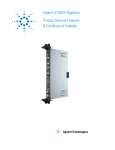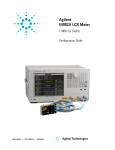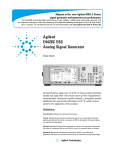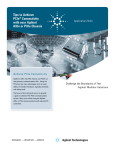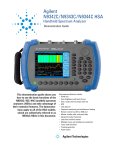Download Agilent Technologies N4962A User guide
Transcript
Agilent Application Block Diagrams for 10 Gb/s BERT Test Systems Application Note Agilent designs and manufactures a collection of low-cost instruments and test accessories, including a 10 Gb/s BERT for 0.5 to 12.5 Gb/s applications. The N4962A serial BERT 12.5 Gb/s can be used for a collection of signal integrity applications as listed below. Each application is discussed in detail with block diagrams in this document. For more information, please contact www.agilent.com/find/contactus 1. Pattern generator for use with oscilloscope 2. BER tester for use with a simple electrical DUT for 10 Gb/s applications N4962A serial BERT 12.5 Gb/s TX CKI RX CKI RX CKO ~OUT TX CKO EXT CKI JitterI HF TrigO LF TrigO 3. BER tester with an external 1/16th rate clock for 10 Gb/s applications OUT IN ~IN DUT 4. BER tester with an external divider for low-rate applications 5. BER tester with an external full-rate clock for 0.5 to 12G applications 6. BER tester with jitter injection for stressed eye testing 7. BER tester with Agilent N4982A clock recovery unit BER testing >12.5 Gb/s Pattern Generator for Use with Oscilloscope The N4962A serial BERT 12.5 Gb/s can be used as a high-performance GPIBprogrammable PRBS (pseudo-random bit sequence) generator. This application is ideally suited for measuring the eye performance of the DUT, including ‘eye mask’ measurements. A simple PRBS generator block diagram is shown in Figure 1; this setup is used to characterize the output performance of the BERT. The two small coaxial loops are shown connecting the BERT clock outputs to the clock inputs. The LF TrigO (615 to 709 MHz) output is connected to the scope trigger input. Oscilloscope N4962A serial BERT 12.5 Gb/s TX CKI RX CKI RX CKO Data input OUT ~OUT TX CKO EXT CKI JitterI HF TrigO LF TrigO IN Trigger input ~IN Figure 1. Block diagram – performance verification with oscilloscope Once the BERT output has been characterized with rise/fall times, RMS and p-p jitter, output amplitude, eye height, signal-to-noise ratio, etc, a common application is to measure the performance of a DUT, shown in Figure 2. Oscilloscope N4962A serial BERT 12.5 Gb/s TX CKI RX CKI RX CKO DUT OUT Data input ~OUT TX CKO EXT CKI JitterI HF TrigO LF TrigO IN Precision Trigger input ~IN Figure 2. Block diagram – DUT eye-mask measurement with oscilloscope 2 In this case, we are using the ‘precision timebase’, a high-precision trigger input on the oscilloscope. This scope input can accept a higher frequency rate trigger signal, and is connected to HF TrigO (a full-rate clock) on the BERT. Even though we are using a more precise method of triggering the oscilloscope, the performance of the DUT is slowing down the transition times and increasing RMS jitter. The scope is shown making an ‘eye-mask’ measurement. BER Tester for Use with a Simple Electrical DUT for 10 Gb/s Applications The N4962A serial BERT 12.5 Gb/s can be used as a high-performance GPIBprogrammable BERT (bit error rate tester). This application is ideally suited for measuring the errors caused by an electrical DUT operating at 10 Gb/s (9.85 to 11.35 Gb/s, to be exact). A block diagram is shown in Figure 3; this setup is used to verify the performance of the BERT. By connecting the OUT directly to the IN, the BERT will measure the amount of signal degradation introduced by the coaxial cable – this should result in BER=0 at most phase adjustment settings. N4962A serial BERT 12.5 Gb/s TX CKI RX CKI RX CKO N4962A serial BERT 12.5 Gb/s TX CKI RX CKI OUT ~OUT RX CKO TX CKO EXT CKI JitterI HF TrigO LF TrigO OUT ~OUT TX CKO EXT CKI IN JitterI ~IN HF TrigO LF TrigO Figure 3. Block diagram – BERT verification measurement DUT IN ~IN Figure 4. Block diagram – BER measurement of single-ended DUT Another block diagram is shown in Figure 4; this setup is used to measure the BER introduced by a simple single-ended electrical DUT. The two cables used to connect the DUT to the output and input do not need to be phase-matched. 3 BER Tester with an External 1/16th Rate Clock for 10 Gb/s Applications The N4962A serial BERT 12.5 Gb/s can also be synchronized to an external 1/16th rate clock for BER measurements from 9.85 to 11.35 Gb/s. This application is ideally suited for synchronizing the BERT with the system clock of a DUT, like a transceiver, SERDES, or CDR. A block diagram is shown in Figure 5. The external low-frequency (LF, clock/16) signal is connected to ExtCKI. The BERT synth option should be changed to 0, and the freq option to the approximate frequency rate (clk/16 * 16). 1, 2 N4962A serial BERT 12.5 Gb/s TX CKI RX CKI RX CKO OUT ~OUT TX CKO EXT CKI JitterI HF TrigO LF TrigO DUT clk/16 IN ~IN Figure 5. Block diagram – BER measurement of DUT synchronized with 1/16th rate clock 1. The clock signal applied to the ExtCKI port must be within the range of 615 to 709 MHz; this signal is multiplied by 16 and output from the TX CKO and RX CKO outputs. Frequencies outside this range will not be correctly multiplied by the BERT internal clock system. 2. To ensure the phase lock of an external LF clock applied to the ExtCKI port, reference the procedure detailed in Section 2.2 of the User Guide. 4 BER tester with an External Divider for Low-Rate Applications The N4962A serial BERT 12.5 Gb/s can also be used for applications below the internal clock range of 9.85 to 11.35 Gb/s, within the operating limits of 0.5 to 12.5 Gb/s. This is accomplished by using an external divider (Agilent offers several programmable units) in the clock path, as illustrated in Figure 6. N4962A serial BERT 12.5 Gb/s ÷N ÷N TX CKI RX CKI RX CKO OUT ~OUT TX CKO EXT CKI JitterI HF TrigO LF TrigO DUT IN ~IN Figure 6. Block diagram – BER measurement of low operating rate differential DUT The output from the BERT internal clock system (RX CKO and TX CKO) is GPIB and front-panel programmable between 9.85 to 11.35 GHz. Using external dividers, part number UXC20PE, the clock can be divided to a lower rate and the test system can be used in the operating ranges listed in Table 1. Because the BERT receiver has an internal electronic phase-adjuster, the coax cables connecting the TX CKO and RX CKO to the dividers, and the dividers to the TX CKI and RX CKI inputs, do not need to be phase matched. Divider Divide ratio Operating range None None 9.85 to 11.35 UXC20PE Divide-by-2 4.925 to 5.675 UXC20PE Divide-by-4 2.4625 to 2.8375 UXC20PE Divide-by-8 1.23125 to 1.41875 Table 1. BERT operating range with external programmable divider Consult the BERT Users’ Guide for detailed procedures regarding the use of an external clock: change the synth option to 0, then adjust the freq setting. 5 BER Tester with an External Full-Rate Clock for 0.5 to 12.5 Gb/s Applications The N4962A serial BERT 12.5 Gb/s can also be used for applications within a full range of operating rates from 500 Mb/s to 12.5 Gb/s. This is accomplished by applying an external clock signal to the BERT clock inputs, RX CKI and TX CKI, as illustrated in Figure 7. N4962A serial BERT 12.5 Gb/s TX CKI RX CKI Power splitter RX CKO ~OUT TX CKO EXT CKI OUT, +10 dBm clock synthesizer OUT JitterI HF TrigO LF TrigO DUT IN ~IN Figure 7. Block diagram – multi-rate BER measurement of DUT with external clock Because the BERT receiver has an internal electronic phase-adjuster, the coaxial cables connecting the power splitter to the TX CKI and RX CKI inputs do not need to be phase matched. The clock input (TX CKI and RX CKI) power input requirements are typically +4 dBm, so the synthesizer should generate more than a +7 dBm output if a power splitter is used. Consult the BERT Users’ Guide for detailed procedures regarding the use of an external clock: change the synth option to 0, adjust the freq setting to the approximate frequency rate. 6 BER Tester with Jitter Injection for Stressed Eye Testing The N4962A serial BERT 12.5 Gb/s also has the capability to inject jitter onto the output PRBS datastream; an important component of IEEE-specified stressed eye tests. This is accomplished by applying an external signal to the JitterI input port as illustrated in Figure 8. Oscilloscope N4962A serial BERT 12.5 Gb/s TX CKI RX CKI RX CKO Data input OUT ~OUT DUT TX CKO EXT CKI JitterI HF TrigO LF TrigO IN Precision trigger input ~IN Function generator Figure 8. Block diagram – BER measurement with jitter injection for stressed eye testing The function generator generates the signal that the BERT FM modulates onto the full-rate clock. This is typically a sinusoid, but the JitterI input could be a square wave, a Gaussian noise source, and even an uncorrelated PRBS bit stream. The JitterI input bandwidth is DC to 100 MHz; the N4962A serial BERT 12.5 Gb/s User Guide spells out the amount of UI that can be injected in Section 2.2. The UI injection vector is also supplied, relating the input voltage to UI of jitter injected. The jitter is applied to the TX CKO and HF TrigO outputs. The RX CKO and LF TrigO outputs are not jittered. The JitterI input requirements range from 0 to 2 V. Consult the BERT User Guide for detailed procedures regarding the use of the jitter injection feature: change the jitter option to 1. 7 BER Tester with Agilent N4982A Clock Recovery Unit The N4962A serial BERT 12.5 Gb/s can also be used with a broadband clock recovery unit, like the low-cost Agilent N4982A clock recovery unit. This “AnyRate” CRU will recover a clock from a PRBS bit stream from 622 Mb/s to 13.5 Gb/s—perfect for use with the wide operating range of the Agilent BERT. By recovering the clock from the DUT output, the BERT can accommodate tests where polarization mode dispersion (or other physical effects) can change the period of the data. This is illustrated in Figure 9. N4962A serial BERT 12.5 Gb/s TX CKI RX CKI RX CKO DUT with PMD E/O OUT ~OUT TX CKO N4982A CRU EXT CKI JitterI HF TrigO LF TrigO O/E Out IN In Splitter ~IN Out Data input CLK output ~CLK output Figure 9. Block diagram – BER measurement with Agilent clock recovery unit A passive power splitter is required to duplicate the output signal of the DUT to feed the BERT and CRU input. If the output from the DUT is severely degraded or very low in amplitude, a buffer or retiming stage may be required to boost the amplitude to meet the sensitivity of the BERT and CRU. If the DUT has a differential output, one side should be delivered to the BERT IN, and the other side should be connected to the CRU input. This will eliminate the power splitter from the block diagram, and will allow operation at lower DUT output levels. This is shown in Figure 10. 8 N4962A serial BERT 12.5 Gb/s TX CKI RX CKI RX CKO DUT with PMD OUT ~OUT E/O O/E TX CKO EXT CKI JitterI HF TrigO LF TrigO IN Data input ~IN CLK output ~CLK output N4982A CRU Figure 10. Block diagram – Differential BER measurement with Agilent CRU The N4982A clock recovery unit will automatically scan between 622 Mb/s and 13.5 Gb/s, and will lock onto the highest-power frequency rate it can find. The recovered clock is ideally suited to drive the BERT error detector. Consult the CRU User Guide for detailed procedures regarding the use of the clock recovery unit. 9 BER testing >12.5 Gb/s The N4962A serial BERT 12.5 Gb/s can be used for testing > 12.5 Gb/s. The pattern generator section is capable of operating up to 15 Gb/s, but the error detector section does not operate above 12.5 Gb/s. However BER measurements can be made above 12.5 Gb/s by using a 1:2 DeMux (N4968A clock and data demultiplexer 44 Gb/s) before the error detector input and checking both de-multiplexed data signals independently. In the example below the N4962A serial BERT 12.5 Gb/s is operating at 14.2 Gb/s—pattern generator runs at 14.2 Gb/s into DUT then into the N4968A configured as 1:2 DeMux, then to the error detector at 7.1 Gb/s(two data streams Data Out1 and Data Out3, tested individually). The sampling scope is optional but can help with timing setup. The N4968A clock and data demultiplexer 44 Gb/s internal clock dividers are set to: • Divider #1, #2 - divide by 2 • Divider #3, #4 - divide by 1 Clock and data demultiplexer Signal generator Splitter 10G BERT DUT Sampling scope Figure 11. Block diagram – BER measurements above 12.5 Gb/s using a 1:2 demultiplexer 10 Setup Instructions 1. Use an external RF signal generator and a 6 dB power splitter to send the clock signal to both the N4962A serial BERT 12.5 GB/Sand the N4968A clock and data demultiplexer 44 Gb/s. 2. Bypass the N4962A serial BERT 12.5 Gb/s internal clock path, and connect the clock signal directly to the pattern generator section clock input TX CKI. A level of +4 dBm at TX CKI should be sufficient. Also connect the N4968A clock and data demultiplexer 44 Gb/s clock output directly to the error detector section clock input RX CKI. 3. May have to increase the clock power to the N4962A serial BERT 12.5 Gb/s pattern generator to get a clean, error free eye, but be careful not to exceed the clock Input 1 level to the N4968A clock and data demultiplexer 44 Gb/s which is about +4 dBm—may want to add an additional attenuator in line, 6 dB should be sufficient. 4. Data input signal to the N4968A clock and data demultiplexer 44 Gb/s must be ac-coupled 1.0Vpp or swing about 0V. A dc block is recommended at the input. 5. Terminate all unused inputs & outputs with 50 Ω loads. 6. Aligning the 14.2G clock and data. Once connected up, adjust the N4968A clock and data demultiplexer 44 Gb/s phase shifter to align the clock and data inputs to the 1:2 demux for error free operation. Do this by monitoring the N4962A serial BERT 12.5 Gb/s BER error light, and also noting the time position of the Data Out4 eye crossing on the scope. NOTE: Make sure the N4962A serial BERT 12.5 Gb/s receiver is OFF at this stage, ignore any BER reading on the display, monitor only the status of the error light. First adjust the N4968A clock and data demultiplexer 44 Gb/s phase shifter until the N4962A serial BERT 12.5 Gb/s error light changes from off to on; note the time position of the eye crossing on the scope. Then move the phase shifter in the opposite direction until it the error light again changes from off to on; note again the time position of the eye crossing on the scope. Then adjust the phase shifter one more time to position the eye crossing midway between the two previously noted values. The 14.2 GHz clock should now be optimally aligned with the 14.2 Gb/s data at the N4968A clock and data demultiplexer 44 Gb/s 1:2 demux. 7. Aligning the 7.1G clock and data. Next optimize the clock and data phase at the N4962A serial BERT 12.5 Gb/s error detector input by using the autophase feature within the N4962A serial BERT 12.5 Gb/s Ensure the Receiver►On is not selected (the error detector must be off Press the Display►Scroll || button and select Ø Press the Adjust►Config State + button to auto-select the detector phase Observe the Error ε light (should remain off, indicating no errors detected) 8. For fine tuning reiterate steps 6 and 7. 9. Turn on the N4962A serial BERT 12.5 Gb/s receiver to perform a BER measurement. 11 www.agilent.com www.agilent.com/find/BERT Agilent Email Updates www.agilent.com/find/emailupdates Get the latest information on the products and applications you select. Agilent Channel Partners www.agilent.com/find/channelpartners Get the best of both worlds: Agilent’s measurement expertise and product breadth, combined with channel partner convenience. Agilent Advantage Services is committed to your success throughout your equipment’s lifetime. To keep you competitive, we continually invest in tools and processes that speed up calibration and repair and reduce your cost of ownership. You can also use Infoline Web Services to manage equipment and services more effectively. By sharing our measurement and service expertise, we help you create the products that change our world. www.agilent.com/find/advantageservices For more information on Agilent Technologies’ products, applications or services, please contact your local Agilent office. The complete list is available at: www.agilent.com/find/contactus Americas Canada Brazil Mexico United States (877) 894 4414 (11) 4197 3600 01800 5064 800 (800) 829 4444 Asia Pacific Australia 1 800 629 485 China 800 810 0189 Hong Kong 800 938 693 India 1 800 112 929 Japan 0120 (421) 345 Korea 080 769 0800 Malaysia 1 800 888 848 Singapore 1 800 375 8100 Taiwan 0800 047 866 Other AP Countries (65) 375 8100 Europe & Middle East Belgium 32 (0) 2 404 93 40 Denmark 45 45 80 12 15 Finland 358 (0) 10 855 2100 France 0825 010 700* *0.125 €/minute Germany 49 (0) 7031 464 6333 Ireland 1890 924 204 Israel972-3-9288-504/544 Italy 39 02 92 60 8484 Netherlands 31 (0) 20 547 2111 Spain 34 (91) 631 3300 Sweden 0200-88 22 55 United Kingdom 44 (0) 118 927 6201 For other unlisted countries: www.agilent.com/find/contactus Revised: January 6, 2012 Product specifications and descriptions in this document subject to change without notice. © Agilent, Inc. 2012 Published in USA, July 17, 2012 5991-0602EN















